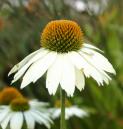Syn.—Jamestown weed.
P. E.—Seeds and leaves.
N. O.—Solanaceae.
N. H.—America, Europe, Asia.
Properties: Anodyne, antispasmodic, deliriant, narcotic; also a mydriatic.
Physiological action: Stramonium is a direct stimulant to nerve force, especially of the sympathetic nervous system. In overdoses it first stimulates the vaso-motor centers, and then paralyzes them. In large doses it increases strength and rate of pulse, causes vertigo, nausea, dry throat, followed by thirst, dilatation of pupils, voice is impaired, secretion of urine increased. In toxic doses there is hallucination which may be of a merry or violent nature. There is a flushed face, injected eyes, pupils are dilated, perversion of sight follows in which everything may appear reddish or greenish. The action of stramonium is similar to that of belladonna and here, too, we have the characteristic rash of the latter. Stupor followed by coma, and in severe cases convulsions and death follow.
Use: In hysterical or excitable mania, tendencies to violent and perhaps uncontrollable reflex muscular trembling. In headache, nausea or vertigo the result of disordered stomach; indigestion of chronic nature, or excessive acid conditions of the stomach it is of value. In patients that are full blooded and who have a tendency to determination of blood to the head it is not the remedy. A valuable remedy in opium habit if alternated with avena sativa.
The Materia Medica and Clinical Therapeutics, 1905, was written by Fred J. Petersen, M.D.

